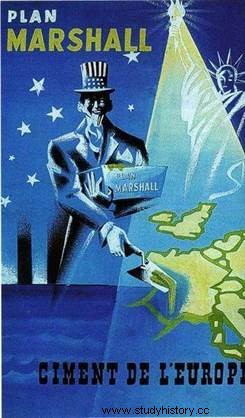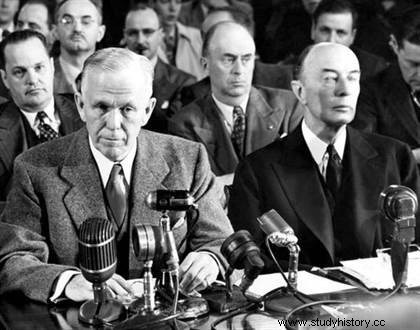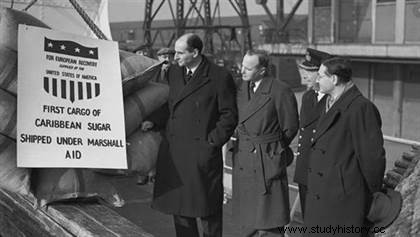 Drafted by US Secretary of State George Marshall in 1947, the Marshall Plan was an economic and financial aid program aimed at contributing to the reconstruction of Europe, devastated by the Second World War. It is as much the fear of seeing a Europe ruined by the war stop supplying itself with American products, as the prospect of seeing communism progress on the Old Continent, which incites the American authorities to propose this plan of economic assistance. to European countries. Between April 1948 and June 1952, more than 13 billion dollars will be devoted to financing this plan, most of these funds being granted as gifts.
Drafted by US Secretary of State George Marshall in 1947, the Marshall Plan was an economic and financial aid program aimed at contributing to the reconstruction of Europe, devastated by the Second World War. It is as much the fear of seeing a Europe ruined by the war stop supplying itself with American products, as the prospect of seeing communism progress on the Old Continent, which incites the American authorities to propose this plan of economic assistance. to European countries. Between April 1948 and June 1952, more than 13 billion dollars will be devoted to financing this plan, most of these funds being granted as gifts.
The Marshall Plan:rebuilding Europe
This program to help rebuild European countries was proposed on June 5, 1947 by General Marshall, then US Secretary of State. In this Harvard speech, General Marshall appeals to all the countries of Europe, including the U.S.S.R. and communist countries, offering American assistance for the material reconstruction and financial recovery of Europe. It is nothing less than avoiding the economic, social and political dislocation of the old continent. Nor does it escape American politicians and economists that the economic fragility of Weimar Germany resulting in part from the policy of reparations had played an important role in the coming to power of the National Socialists.
 This speech is part of the American policy expressed through the doctrine of President Harry Truman, whose objective is to help states to protect themselves from communism (policy of "containment"). Even if, initially, American aid was offered to all the countries of Europe (including the USSR and the communist states), it was nevertheless intended primarily for non-communist nations and was an example of the American desire to turn towards Europe.
This speech is part of the American policy expressed through the doctrine of President Harry Truman, whose objective is to help states to protect themselves from communism (policy of "containment"). Even if, initially, American aid was offered to all the countries of Europe (including the USSR and the communist states), it was nevertheless intended primarily for non-communist nations and was an example of the American desire to turn towards Europe.
To this ideological and political will, we must add an economic reason:Europe indeed represents a promising market; however, because of the rarefaction of the dollar, the European States risk no longer importing and the United States of finding themselves faced with a crisis of overproduction, no longer being able to sell their goods.
Soviet refusal of American aid
Following the American offer, Bidault, Bevin and Mololov, foreign ministers of France, Great Britain and the USSR, met in Paris on June 27, 1947, but could not come to an agreement. Molotov refuses to join a comprehensive plan under the pretext of preserving national sovereignty. Aid was therefore accepted only by the countries of Western Europe, the U.S.S.R. and the communist countries of the East showing towards him an attitude soon clearly hostile.
The acceptance of the Marshall Plan marked the end of the communists' collaboration with the other parties in France and Italy. In response to the Marshall Plan, the Soviet Union decided in September 1947 to create the Cominform, which aimed to harmonize the policies of the communist parties of the States of Eastern Europe, as well as those of the French and Italian communist parties. .
While its official mission is to centralize information of common interest, the Cominform actually serves as an instrument of Stalinist policy, particularly in Yugoslavia where Tito adopts an independent attitude. Opposing the Truman Doctrine point by point, he created an “anti-imperialist” alternative and inaugurated the Cold War between the two blocs.

Recipients of American aid
According to the law signed by President Truman on April 2, 1948, the Marshall Plan was intended to last four years, until June 30, 1952; on this last date, the European countries receiving American aid were supposed to have succeeded in overcoming their economic and financial difficulties.
American aid was accepted by sixteen countries:Austria, Belgium, Denmark, Ireland, France, Great Britain, Greece, Iceland, Italy, Luxembourg, Norway, the Netherlands, Portugal, Sweden, Switzerland and Turkey, to which Federal Germany joined after its birth in 1949. The effort is considerable, it is estimated that it will represent about 1.5% of US GDP over five years.
Essentially distributed in the form of donations, this aid will total more than $13 billion. Receiving 26% of the credits, the United Kingdom is the main beneficiary. It is followed by France (22%), Italy and West Germany (11%). Under the aid of the Marshall Plan, France alone received more than 2 billion 800 million dollars, to which were added other important credits. The Marshall Plan was in fact only one of the aspects of American aid:from 1945 to 1964, American assistance to the whole world amounted to 97 billion dollars, of which France obtained, for its part, 4 billion 443 million dollars.
American aid was offered on particularly advantageous terms (85% free, 15% in long-term loans), but it imposed on Western Europe an orientation towards a sustainable European economic community. Indeed, the Marshall Plan considered Europe as a whole. Two bodies administered the plan:one, the Economic Cooperation Administration (E.C.A.), was American and distributed the credits, which were distributed by a European body, the Organization for European Economic Cooperation (O.E.C.E.).

The results of the Marshall Plan
American economic assistance is therefore limited to Western European nations; massive and mainly in the form of grants, the rest being long-term loans, it takes the form of the establishment of common administrative bodies. The Administration for Economic Cooperation distributes the credits and the European Organization for Economic Cooperation (OEEC, created on April 16, 1848) is responsible for spending them. In 1961, the OEEC was replaced by the Organization for Economic Cooperation and Development (OECD), which widened the scope of cooperation between its various members.
This aid will have kept these economies from collapsing while ensuring the short-term prosperity of the United States. Nevertheless, American aid was nonetheless criticized both by proponents of economic liberalism (who saw in it an excuse to maintain wartime dirigisme, as well as an obstacle to the free market) and by socialists who decried it as an instrument of domination in the hands of the United States. In reaction to the Marshall Plan, the Soviet Union decided to create the Cominform in 1947.
As Cold War tensions escalated in 1949, funds were increasingly used to fund military spending, to the detriment of industrial reconstruction. Above all, accompanied on the political level by the isolation of the communist parties in the countries of Western Europe, the Marshall Plan, if it contributed to the economic recovery of many countries, also reinforced the rift between the capitalist countries and communist countries in Europe, a cut that was to be at the center of the Cold War.
The Marshall Plan has since remained as a benchmark for economic support, so much so that it has become a frequently used expression, whether for the environment or aid for the reconstruction of Haiti.
Bibliography
- The Marshall Plan:At the Dawn of the Cold War, by Benn Steil. Beautiful Letters, 2020.
- American strategy and Europe, by Bruno Colson. Economica, 1997.
Appendix:Distribution of Marshall Plan credits

